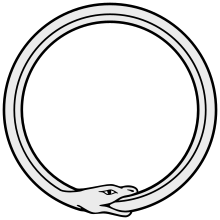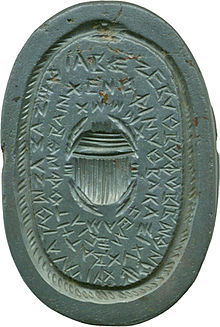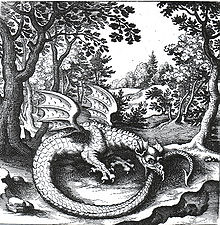Ouroboros

The Ouroboros or Uroborus[1] is an ancient symbol depicting a serpent or dragon eating its own tail.
The Ouroboros often represents self-reflexivity or cyclicality, especially in the sense of something constantly re-creating itself, the eternal return, and other things perceived as cycles that begin anew as soon as they end (compare with phoenix). It can also represent the idea of primordial unity related to something existing in or persisting from the beginning with such force or qualities it cannot be extinguished. The Ouroboros has been important in religious and mythological symbolism, but has also been frequently used in alchemical illustrations, where it symbolizes the circular nature of the alchemist's opus. It is also often associated with Gnosticism, and Hermeticism. Carl Jung interpreted the Ouroboros as having an archetypal significance to the human psyche.[citation needed] The Jungian psychologist Erich Neumann writes of it as a representation of the pre-ego "dawn state", depicting the undifferentiated infancy experience of both mankind and the individual child.[2]
Historical representations
Antiquity
Egypt

The first known appearance of the ouroboros motif is in the Enigmatic Book of the Netherworld, an ancient Egyptian funerary text in KV62, the tomb of Tutankhamun, in the 14th century BC. The text concerns the actions of the god Ra and his union with Osiris in the underworld. In an illustration from this text, two serpents, holding their tails in their mouths, coil around the head and feet of an enormous god, who may represent the unified Ra-Osiris. Both serpents are manifestations of the deity Mehen, who in other funerary texts protects Ra in his underworld journey. The whole divine figure represents the beginning and the end of time.[3]
The ouroboros appears elsewhere in Egyptian sources, where, like many Egyptian serpent deities, it represents the formless disorder that surrounds the orderly world and is involved in that world's periodic renewal.[4] The symbol persisted in Egypt into Roman times, when it frequently appeared on magical talismans, sometimes in combination with other magical emblems.[5] The 4th-century AD Latin commentator Servius was aware of the Egyptian use of the symbol, noting that the image of a snake biting its tail represents the cyclical nature of the year.[6]
Greece
Plato described a self-eating, circular being as the first living thing in the universe—an immortal, mythologically constructed entity.
- The living being had no need of eyes because there was nothing outside of him to be seen; nor of ears because there was nothing to be heard; and there was no surrounding atmosphere to be breathed; nor would there have been any use of organs by the help of which he might receive his food or get rid of what he had already digested, since there was nothing which went from him or came into him: for there was nothing beside him. Of design he created thus; his own waste providing his own food, and all that he did or suffered taking place in and by himself. For the Creator conceived that a being which was self-sufficient would be far more excellent than one which lacked anything; and, as he had no need to take anything or defend himself against any one, the Creator did not think it necessary to bestow upon him hands: nor had he any need of feet, nor of the whole apparatus of walking; but the movement suited to his spherical form which was designed by him, being of all the seven that which is most appropriate to mind and intelligence; and he was made to move in the same manner and on the same spot, within his own limits revolving in a circle. All the other six motions were taken away from him, and he was made not to partake of their deviations. And as this circular movement required no feet, the universe was created without legs and without feet.[7]
In Gnosticism, this serpent symbolized eternity and the soul of the world. The Gnostic text Pistis Sophia describes the disc of the sun as a 12-part dragon with his tail in his mouth.[8]
Middle Ages

The Ouroboros symbol appears in both 14th-15th century Albigensian printing watermarks[9] and is also worked into the pip cards of many early (14th-15th century) playing cards, including Tarot cards.[10] Watermarks similar to those used by the Albigensians appear in early printed playing cards, suggesting that the Albigenses might have had contact with the early authors of tarot decks.[11] The symbol commonly used as the ace of cups in early decks, which is one of the symbols frequently circled with an ouroboros, also frequently appears among Albigensian watermarks.[12] It is conceivable that this is the source of some of the urban legends associating this symbol with secret societies,[13] because the Albigenses were closely associated with the humanist movement and the inquisition it sparked. Because the Albigenses came from Armenia, where Zoroastrianism and Mithra worship were common, it may be that the symbol entered their iconography via the Zoroastrian Faravahar symbol, which in some versions clearly features an ouroboros at the waist instead of a vague disc-shape. In Mithran mystery cults the figure of Mithra being reborn (one of the things he is famous for) is sometimes seen wrapped with an ouroboros, indicating his eternal and cyclic nature,[14] and even references which do not mention the ouroboros refer to this circular shape as symbolizing the immortality of the soul or the cyclic nature of Karma, suggesting that the circle retains its meaning even when the details of the image are obscured.[15]
In Norse mythology, it appears as the serpent Jörmungandr, one of the three children of Loki and Angrboda, who grew so large that it could encircle the world and grasp its tail in its teeth. In the legends of Ragnar Lodbrok, such as Ragnarssona þáttr, the Geatish king Herraud gives a small lindworm as a gift to his daughter Þóra Town-Hart after which it grows into a large serpent which encircles the girl's bower and bites itself in the tail. The serpent is slain by Ragnar Lodbrok who marries Þóra. Ragnar later has a son with another woman named Kráka and this son is born with the image of a white snake in one eye. This snake encircled the iris and bit itself in the tail, and the son was named Sigurd Snake-in-the-Eye.[16]
Alchemy

In alchemy, the Ouroboros is a sigil. Swiss psychologist Carl Jung saw the Ouroboros as an archetype and the basic mandala of alchemy. Jung also defined the relationship of the Ouroboros to alchemy:[17]
The alchemists, who in their own way knew more about the nature of the individuation process than we moderns do, expressed this paradox through the symbol of the Ouroboros, the snake that eats its own tail. The Ouroboros has been said to have a meaning of infinity or wholeness. In the age-old image of the Ouroboros lies the thought of devouring oneself and turning oneself into a circulatory process, for it was clear to the more astute alchemists that the prima materia of the art was man himself. The Ouroboros is a dramatic symbol for the integration and assimilation of the opposite, i.e. of the shadow. This 'feed-back' process is at the same time a symbol of immortality, since it is said of the Ouroboros that he slays himself and brings himself to life, fertilizes himself and gives birth to himself. He symbolizes the One, who proceeds from the clash of opposites, and he therefore constitutes the secret of the prima materia which [...] unquestionably stems from man's unconscious.
The famous Ouroboros drawing from the early alchemical text The Chrysopoeia of Cleopatra dating to 2nd century Alexandria encloses the words hen to pan, "one is the all". Its black and white halves represent the Gnostic duality of existence. As such, the Ouroboros could be interpreted as the Western equivalent of the Taoist Yin-Yang symbol.
The Chrysopoeia Ouroboros of Cleopatra is one of the oldest images of the Ouroboros to be linked with the legendary opus of the Alchemists, the Philosopher’s Stone.
As a symbol of the eternal unity of all things, the cycle of birth and death from which the alchemist sought release and liberation, it was familiar to the alchemist/physician Sir Thomas Browne. In his A Letter to a Friend, a medical treatise full of case-histories and witty speculations upon the human condition, he wrote of it:
[...] that the first day should make the last, that the Tail of the Snake should return into its Mouth precisely at that time, and they should wind up upon the day of their Nativity, is indeed a remarkable Coincidence,
It is also alluded to at the conclusion of Browne's The Garden of Cyrus (1658) as a symbol of the circular nature and Unity of the two Discourses:
All things began in order so shall they end, so shall they begin again according to the Ordainer of Order and the mystical mathematicks of the City of Heaven.
Kundalini Yoga
Ouroboros symbolism has been used to describe Kundalini energy. According to the second century Yoga Kundalini Upanishad, "The divine power, Kundalini, shines like the stem of a young lotus; like a snake, coiled round upon herself she holds her tail in her mouth and lies resting half asleep as the base of the body" (1.82). Another interpretation is that Kundalini equates to the entwined serpents of the caduceus, the entwined serpents representing medicine in the west or, esoterically, human DNA.
Non-western traditions
Some Hindu folk-myths[citation needed] have a snake (Adisesha) circling the tortoise Kurma that supports the eight elephants which support the world on their backs.[citation needed] However, the snake does not bite its own tail, but instead is calling itself into being through what some literary theorists have called a performative speech act.[citation needed]
Snakes are sacred in many West African religions. The demi-god Aidophedo uses the image of a serpent biting its own tail. The Ouroboros is also seen in Fon or Dahomean iconography as well as in Yoruba imagery as Oshunmare.
The god Quetzalcoatl is sometimes portrayed biting its tail on Aztec and Toltec ruins. A looping Quetzalcoatl is carved into the base of the Pyramid of the Feathered Serpent, at Xochicalco, Mexico, 700-900 A.D.
It is a common belief among indigenous people of the tropical lowlands of South America that waters at the edge of the world-disc are encircled by a snake, often an anaconda, biting its own tail.[18]
A map from the late Tokugawa Era named "Jishin-no-ben" has an Ouroborous encircling an area of Japan to explain the cyclic nature of earthquakes.
See also
References
- ^ Greek Οὐροβόρος or οὐρηβόρος, from οὐροβόρος ὄφις "tail-devouring snake", also spelled Uroborus, pronounced /jʊərɵˈbɒrəs/ or /ɔˈrɒbɔrəs/ in English
- ^ Neumann, Erich. (1995). The Origins and History of Consciousness. Bollington series XLII: Princeton University Press. Originally published in German in 1949.
- ^ Hornung, Erik. The Ancient Egyptian Books of the Afterlife. Cornell University Press, 1999. pp. 38, 77–78
- ^ Hornung, Erik. Conceptions of God in Egypt: The One and the Many. Cornell University Press, 2002. pp. 163–164
- ^ Hornung, Erik. The Secret Lore of Egypt: Its Impact on the West. Cornell University Press, 2002. p. 58
- ^ Servius, note to Aeneid 5.85: "according to the Egyptians, before the invention of the alphabet the year was symbolized by a picture, a serpent biting its own tail, because it recurs on itself" (annus secundum Aegyptios indicabatur ante inventas litteras picto dracone caudam suam mordente, quia in se recurrit), as cited by Danuta Shanzer, A Philosophical and Literary Commentary on Martianus Capella's De Nuptiis Philologiae et Mercurii Book 1 (University of California Press, 1986), p. 159.
- ^ Plato, Timaeus, 33; translated by Benjamin Jowett [1]; (original text at Perseus)
- ^ Hornung, Erik ♦ The Secret Lore of Egypt: Its Impact on the West Cornell University Press, 2001, p. 74
- ^ Bayley, Harold S. New Light On the Renaissance. Kessinger, 1909. Page 24.
- ^ e.g. Place, Robert M. The Tarot: History, Symbolism, and Divination. Penguin, 2005. p 21
- ^ van Buren, Anne H. and Edmunds, Sheila. Fifteenth Century Playing Cards and Manuscripts. The Art Bulletin, Vol. 56, No. 1 (Mar., 1974), pp. 12-30. See watermark on p 15 of the article, and cf. Bayley 24-27, 45.
- ^ Waite, Arthur Edward. The Pictorial Key to the Tarot. Rider, 1909.
- ^ Wilson, Robert Anton and Shea, Robert. The Illuminatus Trilogy. Dell, 1975.
- ^ "Mithraic Mysteries". Crystalinks. Retrieved 2012-10-22.
- ^ "Faravahar - Winged Symbol of Zoroastrianism - The Winged Disk". Altreligion.about.com. Retrieved 2012-10-22.
- ^ "Not a full reference, but corroborating". Crystallinks.com. Retrieved 2012-10-22.
- ^ Carl Jung, Collected Works, Vol. 14 para. 513
- ^ Roe, Peter 1986 The Cosmic Zygote, Rutgers University Press
